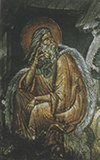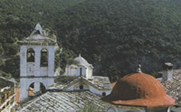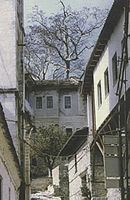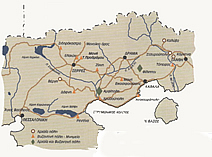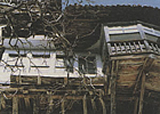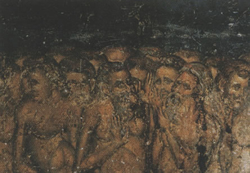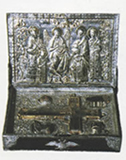MONASTERY OF THE TIMIOS PRODROMOS
Profitis Ilias, 14th Century. The Royal and Stavropegic Monastery of the Timios Prodromos of Menoikios, second in importance within Northern Greece only to the monastic community of Mount Athos, is situated 12 kilometres north-east of the city of Serres
The Phiale. Work from 1854. The Holy Monastery is built in a spot deliberately chosen as "a dwelling-place for men.of impeccable behaviour and untouched virtue.".The founder of the monastery was the Athonite monk, Ioannikios, who was born in Serres in around 1225 and later became bishop of Ezevon.
A view of the monastery. As a young man he gave himself up to the monastic life on Athos, but significant and exceptional events forced Ioannikios the priest-monk to return to the city of his birth to undertake the education of his nephew in his role as guardian.In the company of his nephew, a boy of tender years, he sought refuge on the inhospitable heights of Mount Menoikios in order to continue his holy work Finally, after a period of spiritual growth, he established a small monastery in memory of Kosmas and Damianos, the Agioi Anargiroi, in what is now the village of Chionochori, to the east of the Holy Monastery of the Prodromos. Through his toil, he gave life and beauty to a small, weather-beaten church on the site where the monastery stands today, and made it into something yet more important, a dwelling-place for men, who would struggle daily with humility and modesty to achieve a virtuous life.
View of the interior of the monastery.
Ioakeim, his young nephew, was brought up with care by his guardian and committed himself to the study of letters and a monastic education. Despite the reservations of his spiritual father, Ioannikios, Ioakeim was elected bishop of Zichne, a position he accepted having assured his uncle that he would not forget the monastery of his penitence.Following Ioakeim's crowning as bishop of Zichne, the founder of the Holy Monastery of the Prodromos was elected bishop of the adjacent diocese of Ezevon in Serres Cathedral in 1290. He was to watch over his flock for many years to come. He returned to the Holy Monastery of the Timios Prodromos, where he departed this life in 1300, aged 75. His tomb can be found to the left of the Vespers Chapel. His epitaph reads: "The tomb of our blessed father, Ioannikios, Bishop of Ezevon and founding father of this Holy Monastery, and uncle to Saint John, Bishop of Zichne, who was later to build this monastery. His remains were removed in 1854 along with those of Patriarch Genadios and Saint John, the builder of this monastery."
Detail from the four hundred martyred saints. Following the death of his uncle, Ioakeim, the Bishop of Zichne undertook the task of enlarging and preserving the holy institution. With great care, Ioakeim, the Bishop of Zichne, built and decorated with icons and wall paintings the catholikon of this monastery, while the complex was enlarged to its present size.Emperors and kings granted large tracts of land to the Monastery via golden bulls and offered their direct financial assistance for the expansion and beautification of the entire monastic complex.In 1328 the Diocese of Zichne was upgraded to an archdiocese. Ioakeim, the Metropolitan of Zichne, utilised the prestige of his new position to draw up the Rubric of the Holy Monastery of the Baptist, a document which assured the rights of the monastery and its harmonious running in line with the teachings of Christ. Shortly before his death, Ioakeim resigned from his Metropolitan's throne and returned to his alma mater, the Holy monastery of the Timios Prodromos where he became a monk, taking the name of John.
The end result of Ioakeim, the Bishop of Zichne's, interest in the Holy Monastery of Menoikeos led to his being named the second founder. He departed this world in the monastery on December 12, 1333.During the Fourteenth Century, the Monastery had as its patron Simonida, the daughter of the Emperor of Byzantium, Andronikos Palaiologos the Elder, and wife of the Kraal of Serbia, Uros the Second Milutin. Other emperors who offered their protection and dues to the Menoikeos Monastery were: Andronikos II and III Palaiologos, while Ioannis VI Kantakouzinos and the Serbian leader Stefanos Dousan were generous in their provision of political protection and economic support.
Reliquary. The "Margarit" monastery, as the Turks called it after Ioannou Margaritou, who visited Sultan Osman as ambassador for the monks, requesting him to extend his protection to the monastery, suffered greatly over the years. It was destroyed by Catalan mercenaries and Turks and was abandoned for short periods of time by its monks when the difficulties they faced became temporarily insurmountable.It was το this holy place that the first Ecumenical Patriarch, Gennadios the Scholar, came to recoup his strength after the fall of Constantinople. It was here that he wrote his most important theological works and here that he died in 1472. He is buried in the Monastery of the Baptist. His mortal remains were removed in 1854, and his tomb is now on the right-hand side of the Vespers Chapel.
